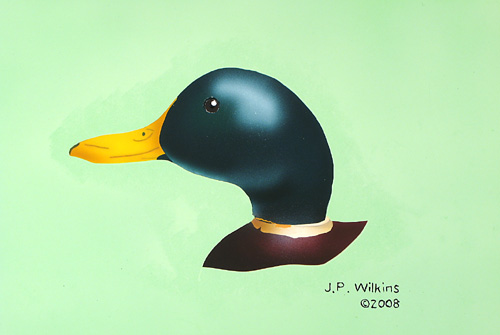Well, I sure hope so! I can tell you one thing for certain though, I know that I’ve missed blogging and now, I’ve got so much to catch up with that I don’t really know where to begin! And, I’ve never really been far away either, just incredibly busy.
For one thing, I finished another decoy head painting, a Mallard this time. (Hey Bill, looks like I’ve got a series going now too. However, with your third painting,

This is from a Charles Hart Mallard drake decoy in the collection of the Peabody Essex Museum, Salem, MA.
you’re still one ahead of me.) I’ve been using these decoy paintings to experiment with different media or methods for the details and such. For example, on the Canvasback painting, I used watercolor with airbrush and traditional brush and on the Mallard, it’s watercolor with airbrush, traditional brush and colored pencils with “stumps,” specifically on the bill (and no, that’s not Bill) and the neck. I’ve also been laying down the background color first which worked well on the Canvasback but not so well on the Mallard.
I’ve now started working on a decorative Green Wing Teal carving that was done by a friend named Francis X. McHugh. He passed away in late 2000 from lung cancer and, to my knowledge at least, he never smoked a day in his life! But he did carve decoys, which creates a very fine sawdust that’s more like baking flour and he used acrylics in an airbrush without wearing a mask or using some other means of ventilation. There’s a lesson in there folks! But, enough of that, now back to the painting. This time, I won’t lay down the background until I’m finished with painting the head, we’ll see how that works. In addition, I thought I might take photos of the work in progress then post them on this blog (or maybe another blog I’ve been putting together [on WordPress, of course]).
Another project that has been keeping me busy is my latest “e-commerce” venture. I’m now on CafePress! (Have patience, though, it’s brand new! A work in progress. I’m still learnin’ how the site works, how to promote it, and so on.) You see, I noticed a number of my images from this blog that many of my visitors seemed especially drawn to, so, I decided to open a CafePress shop where I submit my images, select products that I want my images to be printed on such as post cards, note cards, mousepads, mugs, sweatshirts, etc. and CafePress does the rest. Earlier, I had started putting my images on Etsy (note my Etsy page), however, that site took on a life of its own and became more of an outlet for my sewing or handmade items. CafePress will remain for photos and art from this blog as well as some new stuff.
So, what do you think? I’ve got so much more to write about but I’m still busy with other things too. I promise, though, I’ll be back with blog entries a bit more often ’cause I just can’t stay away from it! It’s addictive! 😀


